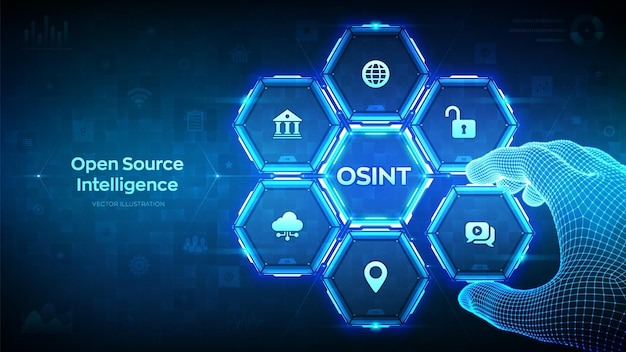As a cybersecurity professional, your job revolves around keeping organizations safe from cyberattacks. You have a variety of tools at your disposal. You also have knowledge you have accrued over the years. Does that knowledge include Open-Source Intelligence (OSINT)?
DarkOwl, a nationally recognized leader in dark web OSINT investigations, knows the importance of OSINT in light of the rapidly evolving threat landscape organizations currently find themselves dealing with. They see OSINT tools and investigative platforms as integral parts of the fight against cyber-attacks.
A Basic Definition of OSINT
The phrase ‘open source’ normally conjures up images of community-built software open to anyone who chooses to use, modify, and distribute it. In the cybersecurity realm, open source is something completely different.

OSINT isn’t a thing. It’s a process. It is the process of systematically collecting, parsing, and analyzing data collected from publicly available sources for the purposes of generating actionable intelligence. Its purpose is to understand cyber threats well in advance so steps can be taken to defeat them.
Publicly available sources tapped by OSINT investigation tools include:
- Social media and blogging platforms
- Web sites (commercial and non-commercial)
- Academic research
- Government publications
- Commercial databases
Comprehensive OSINT tools are even capable of hunting down and gathering publicly available information that isn’t normally indexed by search engines. If data is out there and publicly available, a good investigator can find it.
A 4-Step Process
Organizations like DarkOwl use a step-by-step process to leverage OSINT on behalf of the organizations they serve. There are four steps in the process:
- Data Collection – Relevant data is collected from various public sources using a selection of automated tools and manual searches.
- Data Analysis – Data is analyzed by filtering and processing it. The goal is to extract meaningful patterns, trends, and anomalies.
- Data Interpretation – Analyzed and filtered data is then interpreted. Conclusions are drawn and actionable intelligence is developed.
- Intelligence Reporting – Intelligence is passed on to the appropriate channels where it is used to inform security strategies and operational decisions.
OSINT tools and investigations provide the foundation for identifying and understanding cyber threats before they come to fruition. Doing so gives security experts a leg up. Rather than waiting until an attack occurs and then responding in kind, security experts can utilize OSINT to take the fight to threat actors.
Practical Applications of OSINT Tools
From the standpoint of effectiveness, one of the most attractive aspects of OSINT is that it’s not merely theoretical. It is practical in every way. Cybersecurity experts can leverage OSINT tools and investigations in numerous ways:
1. Threat Detection and Prevention
OSINT tools are deployed to monitor dark web activity. Security experts monitor social media, hacker forums, dark web marketplaces, and other online destinations looking for signs of any potential threats. Leak credentials could be a sign of an imminent data breach. Discussions of perceived vulnerabilities could point to a group of threat actors looking for a way to break into a network.
2. Vulnerability Assessments
OSINT investigations routinely uncover publicly exposed information that could be deployed to breach an organization’s infrastructure. Investigations reveal things like open ports and misconfigured servers. The information is invaluable to security professionals tasked with identifying network weaknesses before they are exploited.
3. Defense Against Social Engineering
Social engineering continues to be a favorite strategy among threat actors because it works so well. A favorite social engineering strategy is phishing. In a phishing attack, threat actors convince unsuspecting victims to voluntarily give up sensitive information. Cybersecurity experts can fight phishing via OSINT investigations capable of revealing what threat actors are up to.
4. Digital Forensics
Cybersecurity incidents tend to be followed by forensics investigations carried out by security experts. Once again, OSINT tools are perfectly suited to such investigations. OSINT offers real time intelligence revealing the size, scope, and nature of the attack in question. Forensic data gathered immediately following an incident is an invaluable resource in developing tools to prevent future attacks.
5. Brand and Reputation Management
Outside of direct cyberattacks, organizations may choose to utilize OSINT tools to better manage their brands and reputations. Investigators use OSINT tools to monitor online mentions of the organization in question. They can also use tools to identify fraudulent websites and accounts. They provide data that organizations need to respond to misinformation.

What Makes OSINT Different
OSINT isn’t the only means of intelligence security experts have at their disposal. It may be used exclusively or in concert with other strategies. The question is this: what makes OSINT different? Why would a security team choose to utilize it?
There are seven things about OSINT that make it stand out:
- Information Sources – OSINT relies exclusively on data that’s available to the public. Other forms of cybersecurity intelligence utilize private, restricted, and classified sources.
- Accessibility – Due to the nature of the information sources other forms of intelligence rely on, access is often restricted. That’s not the case with OSINT. It is fully legal and accessible to anyone and everyone.
- Cost – The financial investment needed to leverage OSINT is comparatively low. Computer hardware and software are relatively inexpensive. Other forms of intelligence require a higher investment in equipment and personnel.
- Speed – OSINT has a distinct advantage over other forms of intelligence due to its speed. Many investigations are conducted in real time. Even when they aren’t, data is gathered and analyzed much more quickly than other forms of intelligence.
- Breadth – OSINT has another advantage and that it is broad enough to address multiple issues and topics. Other forms of intelligence tend to be narrower. They tend to be target-specific.
- Risk – Some other forms of intelligence are inherently risky due to their restricted or covert nature. The risk associated with OSINT is relatively low.
- Reliability – OSINT is less reliable but also less dependent on context. Other forms of intelligence are context dependent but more reliable.
OSINT tools and investigations are the backbone of modern cybersecurity. If your organization is not yet utilizing OSINT, perhaps it’s time to rethink your cybersecurity strategy.



